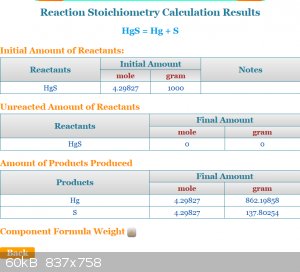| Pages:
1
..
4
5
6 |
Mailinmypocket
International Hazard
    
Posts: 1351
Registered: 12-5-2011
Member Is Offline
Mood: No Mood
|
|
This is the closest that YouTube (aka chemistry school for some) was able to find:
http://youtu.be/znQh7m2mkiQ
|
|
|
Texium
|
Thread Untopped
22-12-2015 at 07:41 |
fusso
International Hazard
    
Posts: 1922
Registered: 23-6-2017
Location: 4 ∥ universes ahead of you
Member Is Offline
|
|
Is cinnabar rly that expensive?!
|
|
|
Texium
Administrator
       
Posts: 4580
Registered: 11-1-2014
Location: Salt Lake City
Member Is Offline
Mood: PhD candidate!
|
|
Is it rly necessary to bump a lot of old threads that have been inactive for years with useless one liners that add nothing interesting to the
discussion?
Answer: no
|
|
|
Johnny Windchimes
Hazard to Self
 
Posts: 61
Registered: 28-5-2019
Member Is Offline
Mood: Sorry, it's my chimes~!
|
|
My turn....
I looked through the whole thread and didn't see this electro process mentioned, so here it is:
I have successfully done this several times. First with 50 grams of Cinnabar from eBay, all the way up to 2 kilograms (stuff is 8.1 g/cm3; dense!).
Get yourself a 2 amp / 20 volt DC power supply and you're off!
My recommendations:
-Use two platinum electrodes. Needs to be made of something that both wont dissolve in the electrolyte, nor amalgamate with the elemental Hg.
-PURE tungsten welding electrodes are also a great choice, as tungsten does not form amalgams either. I have not personally used tungsten but if I do
this again I shall try them. Try automotive supply and welding shops.
-CAREFULLY powderize (as best you can) the cinnabar. This can make dust thats obviously super bad to breath and bad in general to spread around.
Mortar and pestle make a HUGE cloud in my experience; I used a small coffee grinder but that makes even smaller airborne "smoke" almost size dust
particles when its opened.....
-Once its (cinnabar powder) in the mix of NaOH and sulphide, give it LOTS of time to dissolve into solution. Lots of stirring. After it has (or as
much has dissolved as is going to), filter it with a coffee filter and a funnel. If you don't, the junk left over (impurities in the cinnabar, etc)
can amalgamate with the newly formed Hg metal, and it just makes for a cleaner prep.
-Use a secondary containment device. I put the entire electro setup into a nice and big ol' plastic bin in case any spills happened.
Enjoy, because it does work!
Attachment: US1718103 - Cinnabar electrolysis to Hg - Copy.pdf (213kB)
This file has been downloaded 382 times 
[Edited on 8-10-2020 by Johnny Windchimes]
~Incredibly profound and/or wise quote goes here~
|
|
|
monolithic
Hazard to Others
  
Posts: 436
Registered: 5-3-2018
Member Is Offline
Mood: No Mood
|
|
Very old post but can someone explain how this works? I'm just starting to read on this process but it seems it has to run at very high
temperatures... but glass can't withstand 600C+?
|
|
|
Catslovechemistytoo
Harmless

Posts: 13
Registered: 15-7-2024
Member Is Offline
|
|
Quote: Originally posted by Johnny Windchimes  | My turn....
Get yourself a 2 amp / 20 volt DC power supply and you're off!
My recommendations:
-Use two platinum electrodes. Needs to be made of something that both wont dissolve in the electrolyte, nor amalgamate with the elemental Hg.
-PURE tungsten welding electrodes are also a great choice, as tungsten does not form amalgams either. I have not personally used tungsten but if I do
this again I shall try them. Try automotive supply and welding shops.
Enjoy, because it does work!
|
Can titanium electrodes be used instead?
And where to get the Na2S? Can H2S just be bubbled through NaOH solution?
Or can we just dissolve sulfur in NaOH and then use this sulfides solution instead of pure Na2S?
[Edited on 8-9-2024 by Catslovechemistytoo]
[Edited on 8-9-2024 by Catslovechemistytoo]
|
|
|
Precipitates
Hazard to Others
  
Posts: 131
Registered: 4-12-2023
Location: SE Asia
Member Is Offline
Mood: Acid hungry
|
|
I'm not sure of the corrosion of titanium under these conditions - it's resistant at low temperatures, but starts to amalgamate at much higher temperatures. It's labelled as having just "good" compatibility:
Compatibility of Titanium and Mercury
Quote: Originally posted by Catslovechemistytoo  |
And where to get the Na2S? Can H2S just be bubbled through NaOH solution?
Or can we just dissolve sulfur in NaOH and then use this sulfides solution instead of pure Na2S?
|
I would probably try the following patent's method to produce a NaOH and sodium sulphide solution:
Manufacture of sodium sulfide and sulfite
...as mentioned in this previous thread:
Sodium sulphite and sulphide from sulphur and NaOH
Be very careful working with mercury and its compounds - secondary containment is essential.
|
|
|
Catslovechemistytoo
Harmless

Posts: 13
Registered: 15-7-2024
Member Is Offline
|
|
Okay, thank you for your answer. So Titanium should be fine at these temperatures. I think I'll just dissolve sulfur in NaOH solution and try
dissolving HgS in it. As for electrolysis - how do I know when to stop it? My guess is that when H2 or whatever else starts evolving at cathode
besides mercury then it's time to stop.
Can this be done inside of a plastic container(PP or HDPE)? I don't have large borosilicate beakers and doing this in regular glass is risky because
it can crack.
|
|
|
Precipitates
Hazard to Others
  
Posts: 131
Registered: 4-12-2023
Location: SE Asia
Member Is Offline
Mood: Acid hungry
|
|
When mercury stops being produced.
HDPE should be okay.
|
|
|
| Pages:
1
..
4
5
6 |